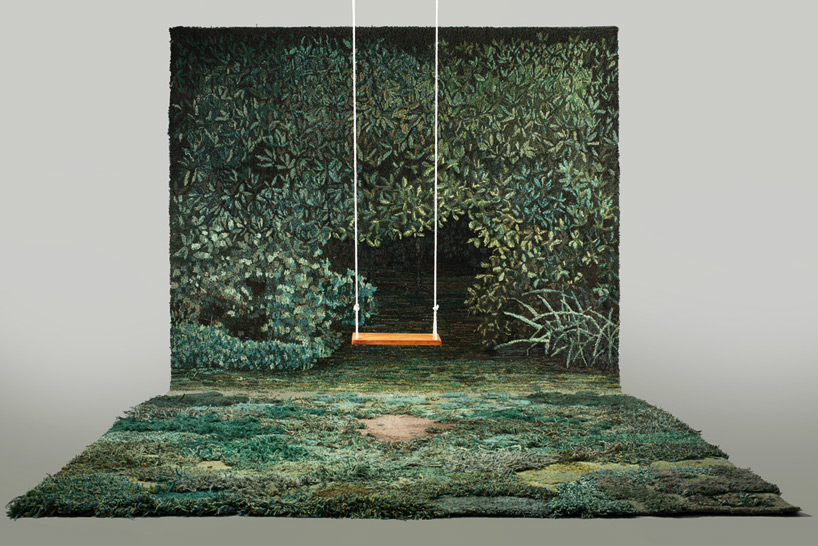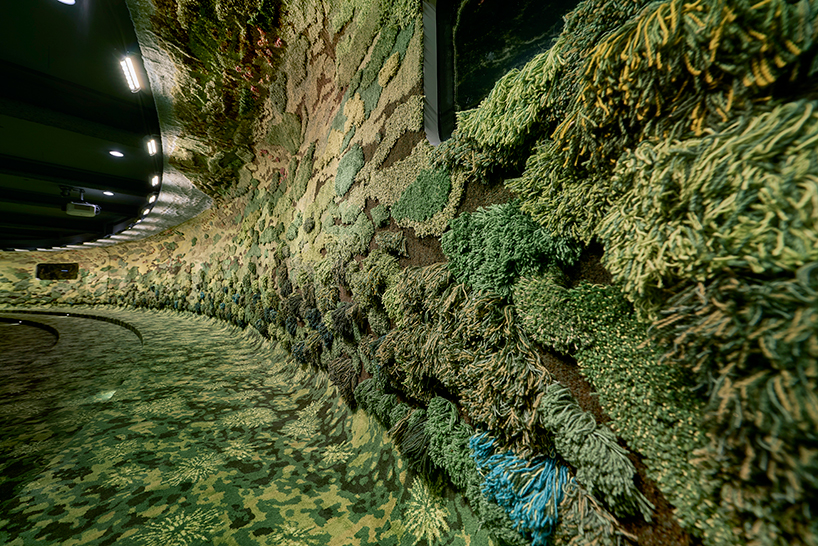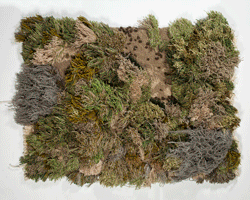the very first time artist alexandra kehayoglou built a carpet with her hands, it was an innate and instinctive attraction. ‘I was connecting with my paternal grandmother, a fierce woman whom I had never met,’ she tells designboom in an interview. ‘she managed to raise four children and build a company starting with a loom she carried with her across the atlantic ocean. I knew there was something there, it felt right. it was like discovering a close friend. something ancestral awoke in me and it all started to make sense’. since then, the argentine textile artist has rooted her practice in the use of available materials and existing resources to create intricately woven landscapes depicting grasslands, fields, and disappearing terrain. her craft has become a symbolic outcry against deforestation and devastation, and a call for environmental awareness. ‘I believe that art can be a mirror, and I try with my work to reflect our humanity in relation with the landscape,’ she shares. ‘my carpets, thus, became instruments for documenting ‘minor’ aspects of the land which were otherwise overlooked as irrelevant. a focus on its micro-narratives that would open new doors for possible ecological futures.’
in an interview with designboom, alexandra kehayoglou spoke about her connection to natural cycles, living on an island in the parana wetlands, and the importance her work places on the preservation of the environment.

2020 work from the series prayer rugs | all images courtesy of alexandra kehayoglou
DB: what aspects of your background and upbringing have shaped your creative principles and philosophies?
alexandra kehayoglou (AK): I am the middle daughter, the black sheep. I had to find my space in a family that was not particularly traditional, where a generational gap distanced me from my father. he was 50 when I was born. he was raised by two greek exiles who got into an arranged marriage to start a new life in argentina.
this meant a constant challenge. I have always had my idea of things, and a personal perspective. I connected with animals and plants from a very small age, and art and self expression had always been a shelter where I could stay still. silence and introspection always were safe places. I grew up thinking I could become whoever I wanted. there was this pressure to continue with the family tradition of the carpet company. but it somehow didn’t really feel right.
there has always been this voice inside me. one that whispers, ‘through here’ and when I, for some reason, lose track — it starts to scream, ‘through here! through here!’ this has made me stay focused in this direction. I had to build a personal path. my work and me being an artist didn’t really fit in a traditional or conventional way. I was always pulled by a high sense of ethics that corresponds with this inner voice. this is probably why I started to worry about ecology at a very young age. in the 90s, we started composting organic waste. this was not common in my country back then. I was born in a house with a very large garden, background, a forest, a farm — in the suburbs, right next to the river. I guess this connected me with natural cycles and tuning a dialogue with a natural world.

refugio para un recuerdo (shelter for a memory), 2012
textile tapestry (handtuft system), wool | 270 x 500 cm
DB: what draws you to textile materials as an artistic medium, and what are their personal meanings to you?
AK: I was not drawn particularly to textiles when I studied arts at university. this is something that started to develop in me in my late 20s. I sort of felt a need to incorporate available materials — existing resources that were there, close, being wasted was my way of connecting to this idea of not ruining more of the world with my art back then. but when I started to manipulate them, the first time I got to build a carpet with my hands, not really knowing what I was doing, I had no training nor help at all. I knew there was something there, it felt right, it was like discovering a close friend. something ancestral awoke in me and it all started to make sense.

refugio para un recuerdo II (shelter for a memory II), 2016
textile tapestry (handtuft system), wool | 206 x 140 cm
AK (continued): textiles weren’t so fashionable back then. it was 2006 — carpets were, for many, an uncomfortable item you had to take care of. art was really very far away from a carpet. I was working at the family company and this was a thing. but this connection felt stronger than anything else and it simply made so much sense. I was connecting with my paternal grandmother. a fierce woman whom I had never met. when she got to argentina she met my grandfather, he was not particularly a very graceful man. she managed to raise four children and build a company starting with a loom she carried with her across the atlantic ocean. this loom turned into a shelter. she was able to overcome so much being mistreated by this man. these were difficult years. being an exile in a new land. I have connected with her story and relieved things with her. it was hard for me to be an artist in my family.
I had to face many demons. my grandmother represents this luminous aspect, but there’s also this dark side. my father supported my work, he was always there pushing his own limits of understanding for me to be who I really wanted to be. but he got very sick five years ago with ALS, and this support disappeared. the family company turned into this dark entity that wanted to devour my work. so I’ve been staying as far as possible. trying to feed my grandmother’s memory. textiles carry on things. karma is one of them.

kehayoglou wrapped an MVRDV-designed theater in taiwan in textured green tapestries
image by JUT group | read more on designboom here
DB: where do you work on your projects, and what are the creative strategies you adopt when working?
AK: I don’t really feel I have strategies. it depends on the project, if it is a specific situation of an ecocide, or just a representation of a landscape. I do work a lot with intuition. I try to connect deeply with what resonates inside, and to tune into a message that comes from the land — lately I’ve been doing this a lot. coherence is very important for me, it has to make sense. the last project I have been working on, on this island we live in when we are in buenos aires, a land that belongs to an ecosystem that has been altered and destroyed. I started to focus more on this.
in the last two years, I’ve been living on an island. the pandemic and COVID forced my family to fulfill this dream of living in nature. this is a land that conforms to a very unique landscape within buenos aires. the wetland.

kehayoglou used a hand-tufting process to fabricate the wool textiles that cover the walls
image by JUT group | read more on designboom here
DB: how planned is the configuration of each piece? is there room for spontaneity and improvisation while you are working?
AK: some works are carefully planned, milimetrically, but it’s textiles and there’s always some spark of spontaneity and definitely improvisation.
ever since projects started to acquire large dimensions, and I incorporated assistants to help me produce the works, this meant losing control of every single detail as well — and it actually got more interesting.

return to a loving dream | window installation on display at hermès liat towers in 2019 | image by francisco nocito
DB: which project has been the most challenging to execute? what were the challenges?
AK: the project I made for taiwan some years ago was a very challenging project. this is PANORAMA 360, a commissioned lecture hall for JUT group in taipei, inside their museum. it was challenging because of its dimension, because of the complexity of following an idea that was only imaginary. the challenge to translate this imaginary world into an ambience.
also it was a challenge because I specially designed an industrial, eight color carpet for the floor of the lecture hall, and this had also to be translated into the textiles that were projected on the walls. also it had to be easy to install, it had to be divided into so many pieces, and the construction and technical part of the project was a big challenge too.

return to a loving dream (detail) | window installation on display at hermès liat towers, 2019
image by francisco nocito
DB: much of your work deals with landscape and an overriding awareness of the environment, deforestation and the extinction of the wilderness — can you talk about the idea of preservation, and how your work captures these realities?
AK: I believe that art can be a mirror, and I try with my work to reflect our humanity in relation with the landscape. preservation is very important for me, since in 2018 my partner jose huidobro and I became guardians of a piece of island located in the wetlands of the paraná river, which is born in southern brazil and descends onto the estuary of the river plate to finally reach the atlantic ocean. after decades of exploitation, the land I am referring to seemed to have forgotten who she was. dead streams, clogged arteries, utter devastation.

santa cruz river, 2016-2017
textile tapestry (handtuft system), wool | 980 cm x 420 cm
AK (continued): when we managed to escape the confinement of our urban lodgings, we met a different kind of isolation; this one on an island by a river. an ever changing garden of eden whose voice I soon connected with. this time, that voice was full of sorrow as if trying to convey an untold story. something was certain — those new conditions were a once in a lifetime opportunity to learn to decipher those messages that would allow us to transform unbearable loss into hope.
isolation made me think of my carpets as spaces where new forms of activism could be enacted. a type of activism that, instead of focussing on paranoid conflict, was silent, absorptive and, as I believe, more effective. my carpets, thus, became instruments for documenting ‘minor’ aspects of the land which were otherwise overlooked as irrelevant. a focus on its micro-narratives that would open new doors for possible ecological futures.

santa cruz river, 2016-2017 | textile tapestry (handtuft system), wool | 980 cm x 420 cm
DB: in a world that is increasingly virtual, your work is firmly rooted in tactile and physical experience. do you think society today is moving too far away from traditional ways of making and craftsmanship?
AK: I believe that crafts have managed to trespass the screens that we live with. we are having today the possibility of living both virtual and physical experiences. textiles have the capacity for us to relate organically with our bodies, since our biggest textile organ which is the skin, connects us to the physical world outside us.
I think both things are happening at the same time, there is a need to recover forgotten techniques and ways of doing, we are starting to feel that need and looking for an answer to that calling.

santa cruz river, 2016-2017
textile tapestry (handtuft system), wool | 980 cm x 420 cm
DB: what themes do you hope your work provokes discussion about?
AK: memory is important for me. it is not so much about thinking, but about provoking a physical change. I really feel that if this comes from an embodied consciousness, then it’s more likely that we connect with other realities and perspectives.

hope the voyage is a long one, 2016
textile tapestry (handtuft system), wool
DB: what are you currently fascinated by, and how is it feeding into your artistic practice?
AK: living on the island in the parana wetlands was very fascinating. this fed into my work with a large body of documentation and understanding the way a piece of land comes back to life when exploitation is stopped. having the possibility of working in this reserve for three years was unique, being able to stay at the site for many weeks taking the time needed to absorb the place at full.

land with symbols, 2020 — part of the series prayer rugs
AK (continued): today I am embarking into a new project which also fascinates me. I am now in crete where I came to learn how to weave using the traditional greek weaving techniques.
here in crete, I will be staying at the agia irini convent in rethymnon, where the nuns have welcomed me to work together with them and learn how to use a traditional loom. this new voyage is truly fascinating in so many ways, since it means a lot for my family history, for the karma carried with my grandparents having to leave isparta in 1922 during the war, and now me coming back to follow my grandmother elpiniki’s passion craft. she carried the loom in the boat to go from greece to argentina — I am now coming from argentina into greece, 100 years later, to embrace the tradition that got lost in that journey.

land with symbols (detail), 2020 — from the series prayer rugs

sur l’herbe, 2017
textile tapestry (handtuft system), wool | 980 x 450 cm

sur l’herbe, 2017
textile tapestry (handtuft system), wool | 980 x 450 cm

winter microcosmos details of the wetlands 3, 2020 — from the series prayer rugs
alexandra kehayoglou (5)
art interviews (152)
carpets and rugs (40)
textile and fabric art (33)
PRODUCT LIBRARY
a diverse digital database that acts as a valuable guide in gaining insight and information about a product directly from the manufacturer, and serves as a rich reference point in developing a project or scheme.






















